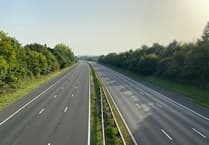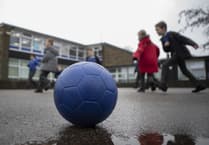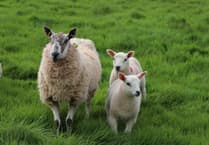John Woodhouse, who will be 100 years old on Monday, October 9 conjoins two of Abergavenny’s now best-known families – though half his immediate forebears were relatively recent arrivals in the town.
His first few months were spent with his parents in one of the ancient houses on Mill Street of a great-grandfather, who with his wife had migrated from Wiltshire; in boyhood he spent holidays on the ancestral Herefordshire farm then run by his paternal great-uncle; and his maternal grandmother kept it very quiet that at the close of Queen Victoria’s reign she had come from Suffolk to be a teenaged barmaid for distant cousins who ran the town’s oldest pub, Golden Lion on Frogmore Street.
His father, Billy Woodhouse, was an engineer in the fledgling RAF 1918-22, mostly on India’s North-West Frontier servicing Bristol fighter bi-planes and commanded by the man who would later become famous as Sir Arthur “Bomber” Harris. On his return home, he married Pippy Williams of 24 Monk Street, just across the road from St Mary’s, whose cabinet-maker father had turned to coffin-making and the funeral business that survives today. John, their only child, was born in the Cottage Hospital on Hereford Road.
When he was three his parents moved to work in South London but he remained in Abergavenny to be brought up by his Woodhouse grandparents alongside their own younger sons in Scarborough Cottage, North Street.
John attended King Henry VIII Grammar School where he was a leading Scout and excelled at rugby and swimming.
In 1938, at the opening of the public pool in Bailey Park, he met Shirley Thomas, daughter of the owners of the Grofield Inn and later head girl of the Girls High School. When war broke out the following year he happened to be with his parents in the capital and, keen to follow his father into the RAF, promptly abandoned plans to become a doctor and moved to live with them.
After marking time until old enough for active service by working at a South London metals refining company owned by a member of the Fry chocolate dynasty, in January 1942 John was finally able to volunteer for Bomber Command, by now led by his father’s old boss, Harris. A year’s training in Canada to be a bomb-aimer/navigator followed and he returned to combat duty in the RAF’s latest huge Lancaster bombers from bases in Suffolk and Lincolnshire. Through late 1943 and most of 1944 – when 50 per cent of Bomber Boys were killed in action - his seven man crew in “Q for Queenie” of XV Squadron, flew more than 30 sorties across Germany and occupied France. One notable mission was a raid shortly after D-Day on Nucourt to the north of Paris when 300 deadly V1 rockets, intended to be launched against London, were destroyed in their underground launch site. John was awarded the Distinguished Flying Cross eleven days after his 21st birthday that year - “having invariably displayed the utmost courage and devotion to duty” said the citation - and was switched to other duties: dropping food parcels over the Hague on VE Day, ferrying troops back from Bari, southern Italy and eventually becoming a trainer of bomb-aimers himself until he left the RAF in August 1946.
On being demobbed, he went back to Fry’s where his boss had paid him his old wage at the firm throughout his RAF service because he thought John had management potential and wanted him to return. Very quickly he was sent to join a British team of managers who ran the company’s large Indian subsidiary in Calcutta, arriving there barely two months before Indian Independence in August 1947, which was marked in that city and surrounding Bengal by grisly communal violence. A large British business community remained in the city, then financial capital of India, and its beguiling pre-Independence social life of sports and night clubs continued. John, for example, played until he was 35 for the Calcutta Football Club, the world’s oldest rugby club outside the UK which in the 19th century had provided the silver rupees which were melted down to make the trophy for the annual match between England and Scotland. On his first three months “leave” in 1949 he headed straight to Abergavenny and proposed (on the bench outside the churchyard of St Peter’s, Llanwenarth) to Shirley Thomas, by then a teacher in a Herefordshire junior school. They married in St Mary’s that August and honeymooned in Cornwall before he had to sail back to India only days later. The next year his bride followed him to Calcutta, where their two sons were born in 1951 and 1957.
“Leaves” from India in 1952 and 1955 included lengthy stays with his wife’s parents, who had sold the Grofield after their daughter left and moved to Pembroke Lodge, Merthyr Road, whose magnificent iron railings along its road frontage are included in the house’s now Grade II listing. When this was in turn sold after his mother-in-law’s death, John maintained regular contact with both sides of his own extensive Abergavenny family and was always punctilious to attend their most significant rituals. By then he had prospered in Calcutta, becoming managing director of the firm there in 1956 and also a church warden of the city’s Gothic-style St Paul’s Cathedral, where he would eventually escort the visiting Archbishop of Canterbury, Michael Ramsey, and a year later the Queen and Prince Philip. With Shirley he took an active role in the charity work the British community carried out in the city: as director eventually of the East India Charitable Trust, which provided homes for Calcutta’s poor, he was one of the first funders of the work of Mother Teresa who at their many meetings used to call him “Jawn, Jawn” in her strong Balkan accent.
On one of his frequent business trips to the Indian capital, Delhi, he took his wife and elder son with him and the firm’s agent there arranged for the boy to meet the country’s founding Prime Minister, Jawarhalal Nehru, at one of the latter’s early Sunday morning levees. The nine-year-old was accompanied by his parents to the official residence and the meeting took place in the teak-pannelled drawing room by the French windows onto the elaborate gardens - through which Nehru’s daughter and Prime Minister in her turn, Indira Ghandi, would walk out to her assassination 24 years later.
From the early 1960s increasing financial restrictions were placed by the Indian government on British business people in order to encourage them to leave the country as the colonial administrators had done previously. The final straw was a drastic limit on the amount of money which expatriates could send back to the UK – thus throttling their ability to meet their children’s school fees in British boarding schools. John took swift action and in 1963, still short of his 40th birthday, brought his family back to England so he could work instead at Fry’s headquarters and they settled in a house on the outskirts of Epsom which he had bought on a previous “leave”.
While retaining oversight of the Indian company, he was assigned control of Fry’s important printing metal operations and various subsidiaries producing specialist metals like pewter. This meant much travel to Europe and the US and, having worked his way up the corporate ladder of the UK firm, now part of a much larger conglomerate, he was appointed in 1983 chief executive of what had become Cookson Fry. Just before retiring from this position aged 65, John with Shirley made a last visit to Calcutta and his retention for some years thereafter of various consultancies, as well as his leading role in pan-European metals associations, provided them with further opportunities for foreign travel on top of their own holidays abroad.
Greater leisure time also allowed him more opportunities to play tennis and snooker with a neighbour who had become his closest local friend, Jack Ashley, the deaf Labour MP for Stoke on Trent then life peer. While, in tandem with Shirley, he was active in local environmental and educational community groups. The couple now worshipped at St Mary’s, Headley near Epsom, a piquant choice since John used to cycle out to the simple church in the Surrey Hills in the early years of the war, and the they delighted in the professional achievements of their sons, a Fleet Street journalist and a tax consultant, the latter of whom provided them with three grandchildren from 2003 onwards.
On their diamond wedding anniversary in 2009 John and Shirley received congratulations from the Queen and inevitably he was heartbroken when his wife of more than 66 years died suddenly at the age of 89 in April 2016. Five months later John, though rising 93, drove himself to Abergavenny for an extended final visit to his native town, during which, as well as visiting cousins, he raised a glass to Shirley’s memory in the Grofield from which she had left in her wedding dress so long before.
The following year he chose to move into a flat in a new retirement home on Epsom Downs, which he calls his “hotel with extra care” and from which he visits every week what he dubs his pub, the RAC Woodcote country club, a few miles away.
“I’ve been a very lucky chap” says John. “ I just can’t believe I’m going to be 100.”




